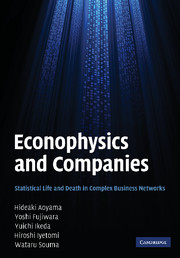Book contents
Foreword
Published online by Cambridge University Press: 06 August 2010
Summary
This book is one outcome of the new field of econophysics, and explains a wide range of recent findings relating to the dynamics of companies. While economics and physics each have long histories of their own, and their methods and purposes are obvious, econophysics, which has only a twenty-year track record, is still unfamiliar to many. Indeed, an emerging interdisciplinary approach in which the economy is studied with the tools of physics may provoke doubts as to whether the methods of a hard science can tell us anything about phenomena in which human beings are essential players. However, economics has in fact mimicked physics since the nineteenth century. This is particularly true of those who developed modern economics, the ‘neoclassical’ economists. The old masters such as Alfred Marshall and Léon Walras all drew inspiration from Newtonian mechanics. The fundamental concept of ‘equilibrium’, known to all students of the subject, is, of course, borrowed from physical science.
Thus, a moment's reflection shows us that the relation between physics and economics is long-standing and far closer than is commonly realised. Nevertheless, the recent development of econophysics represents a significant development. While traditional economics learned from classical mechanics, which analyses behaviours such as that of a ball thrown in the air or the motion of a weight at the end of a spring, econophysics looks to the statistical methods of the modern physicist.
- Type
- Chapter
- Information
- Econophysics and CompaniesStatistical Life and Death in Complex Business Networks, pp. xix - xxPublisher: Cambridge University PressPrint publication year: 2010
- 1
- Cited by



